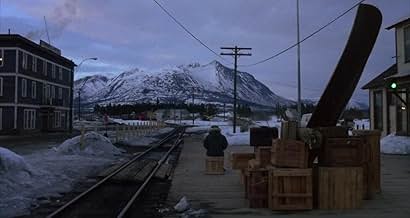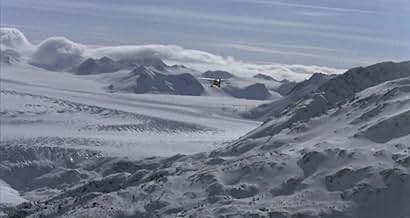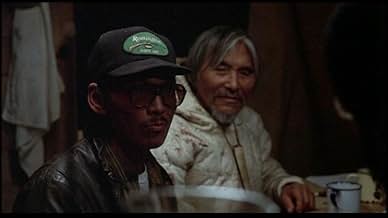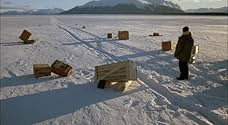Un jeune biologiste est envoyé dans les contrées sauvages de l'Arctique pour enquêter sur les loups. Tandis qu'il étudie leurs mystérieuses habitudes, ses premiers contacts avec les forces d... Tout lireUn jeune biologiste est envoyé dans les contrées sauvages de l'Arctique pour enquêter sur les loups. Tandis qu'il étudie leurs mystérieuses habitudes, ses premiers contacts avec les forces de la nature sont difficiles.Un jeune biologiste est envoyé dans les contrées sauvages de l'Arctique pour enquêter sur les loups. Tandis qu'il étudie leurs mystérieuses habitudes, ses premiers contacts avec les forces de la nature sont difficiles.
- Réalisation
- Scénario
- Casting principal
- Nommé pour 1 Oscar
- 4 victoires et 3 nominations au total
Avis à la une
There are two subtle elements of wilderness, that unless you have experienced them, you will probably miss in the movie, silence and melancholy.
When one experience solitude and wilderness as Tyler does, the first thing you notice is the silence that surrounds you. The only noises that can be heard are the ones you make, and simple actions like scratching your hand, striking a match, or the rustle of your nylon parka as you simply move all become a symphony of noises you never noticed before.
The director, Carroll Ballard, takes great pains to illustrate this in the beginning of the movie( knowing all the while most viewers will miss these subtleties) as Tyler is left on the a frozen lake with all his gear strewn about. Rosie guns the engine to his plane for the third time and finally gets to takes off. The sound of that single engine plane is deafening and overpowers everything within 25 miles, but the silence Tyler is left with as the last throb of the plane's engine disappears in the distance is even more so. All of Tyler's actions at this point center around the noise they make. Notice this when you watch.
The next element of wilderness and solitude the director so painstakingly portrays is melancholy. There is no better way to describe it. Melancholy is an intangible, an emotion, yet for any who have experienced wilderness on the level that Tyler does knows how overwhelmingly real it is. It is palpable. The melancholy not only comes from within but comes from all around. It is an element of wilderness that is there even if man is not.
The scene that best depicts this melancholy is when Tyler is out sitting on the rock, alone, with only creatures of the tundra to keep him company. It is twilight. His hair and glasses are wet from an earlier snow, and he sits and plays his oboe. Not a song but a phrase, an echoing phrase that sings out his loneliness to the empty expanse. And off in the distance is a kindred reply, the howl of a lone wolf, a cry that says I know, I understand.
Never Cry Wolf is a tremendous film and is equally underrated. In one sense it is a master piece, one that will never receive mass appeal or recognition. It speaks to us on multiple levels and with subtle intensity, but unfortunately most of us aren't able to hear the message.
Hedeen's Outlook: 8/10 *** B
Another trait that immediately stands out about this movie is its striking rawness. For a good part of the film, the main character narrates, and one gets the feeling he's writing home, as opposed to telling an audience. This adds both an intimacy and a sincerity and is very effective.
Though it is largely unknown (and therefore largely under-appreciated), Never Cry Wolf is a beautiful, complex and forceful. A high point for Disney -- no contest.
"Never Cry Wolf" is a wonderful film with magnificent cinematography and beautiful story based on the biography of the Canadian Farley Mowat. Presently the film gives the sensation of a National Geographic movie but it was very impressive and unique in 1983 when it was released. Maybe this is the best role of Charles Martin Smith, performing a scientist living in the wilderness alone for a long period and understanding the behavior of wolves. Last but not the least, the ecologic concern of this film is ahead of time. My vote is seven.
Title (Brazil): "Os Lobos Nunca Choram" ("The Wolves Never Cry")
Le saviez-vous
- AnecdotesIn real life, Farley Mowat's research in the Caribou changed the way humans understand the wolf species.
- GaffesThe lead claims the wolves eat mice, which he proceeds to eat, but they are voles, not mice (which don't occur in the arctic).
- Citations
Rosie: We're all of us prospectors up here, eh, Tyler? Scratchin' for that... that one crack in the ground. Never have to scratch again. I'll let you in on a little secret, Tyler: the gold's not in the ground. The gold's not anywhere up here. The real gold is south of 60 - sittin' in livin' rooms, stuck facin' the boob tube, bored to death. Bored to death, Tyler.
- ConnexionsFeatured in The Making of 'Never Cry Wolf' (1983)
Meilleurs choix
- How long is Never Cry Wolf?Alimenté par Alexa
Détails
Box-office
- Montant brut aux États-Unis et au Canada
- 29 600 000 $US
- Montant brut mondial
- 29 600 000 $US
- Durée
- 1h 45min(105 min)
- Couleur
- Mixage
- Rapport de forme
- 1.85 : 1









